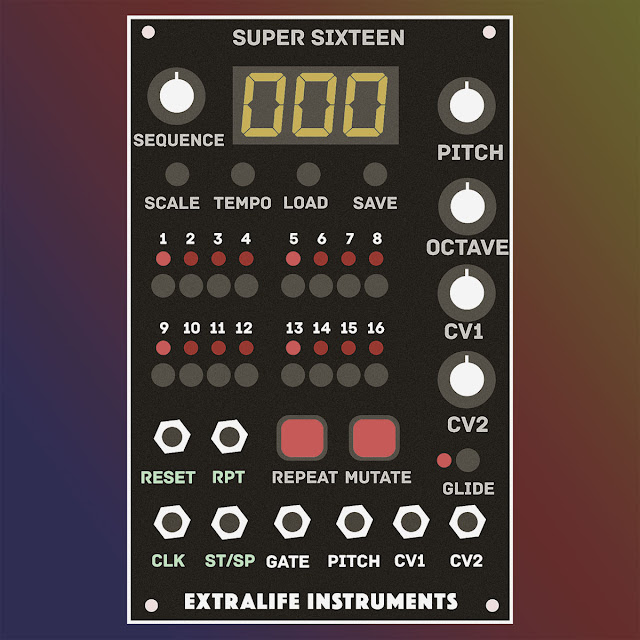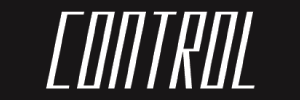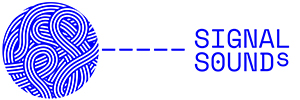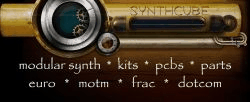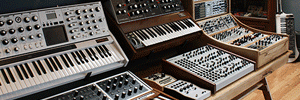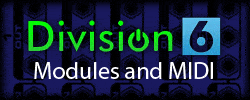
Showing posts sorted by date for query Dual Digital Shift Register. Sort by relevance Show all posts
Showing posts sorted by date for query Dual Digital Shift Register. Sort by relevance Show all posts
Monday, February 05, 2024
The Eternal Now
video upload by davidryle
"American Format (5U) modular synthesizer performance in real time to a stereo track in Cubase.
For an atonal wash I used the Dove Audio Waveplane and WTF vco's through an Oakley Sound Systems Ring Modulator. I then sent it through A dotcom Q150 transistor ladder filter and a Lower West Side Studio Multimode Filter/Resonator and on to a fixed filter bank and a Frequency Central Stasis Leak digital delay. This drone wash comes in at the final section and ending.
The opening reed sound and accompanying organ sounds were derived from the Synthetic Sound Labs/Mutable Instruments (Braids) Woven Spirits module.
The initial reed sound is from the AUX output of the Woven Spirits through an SSL/Ian Fritz 5 Pulser and Oakley Sound Systems State Variable Filter. The filter is stepped with a random S&H from JNP Electronics.
The secondary organ chord sound is the Main direct output of the Woven Spirits in Chord mode. The combination of both elements are sent to an Electro-Harmonix Grand Canyon in DMM mode. Feedback is applied as needed for the drone sustain throughout the piece.
The bass line comes in next with a pair of STG Soundlabs Oscillators through a Dove Audio D502 Multimode filter in -24dB LP mode. The pitch voltage is from the upper Q960 step sequencer. It's timing is from a Catgirl Synth Master Divider, clocked from a custom Dual LFO/Analog Shift Register of Ken Stone (Catgirl Synth) design. An additional tap from the STG oscillator through a Corsynth C103 Frequency Divider/Multiplier module for a sub-octave feed.
The melodic line blended into the latter section is from a pair of Q106 dotcom vco's which are pitch controlled by the lower Q960 sequencer. Each vco pitch is from a separate row of the Q960. The Q960's shift timing is from the CGS Master Divider module. The output is routed through an Empress Reverb pedal in Blue Ghost mode. Panning is from the LWSS/Yusynth Panning Mixer.
All pitch quantitization is through a Moon Modular 565 series setup.
Additional voltage modulation to the Woven Spirits module are from the STG Soundlabs voltage mini stores, and vaious LFO's etc. Timing for the additional sequencers is also managed by the Moster Divider."
LABELS/MORE:
5U,
Catgirl,
Corsynth,
CSG,
Dove Audio,
EHX,
Frequency Central,
Ian Fritz,
JNP,
Lower West Side Studio,
Mutable Instruments,
Oakley,
SSL,
STG,
synthesizers.com
Sunday, January 07, 2024
Exploring clocks, loops and chaos with Rung Divisions from Fancyyyyy Synthesis
video upload by Tom Churchill
"This video is about Rung Divisions, by Fancyyyyy Synthesis. It’s one of the most inspiring modules I’ve used recently, but it’s also quite a hard one to sum up in one sentence.
It has two main components. The first is a clock divider which outputs pulses that you can combine in two buses to create polyrhythmic patterns. That drives a universal shift register which outputs pseudo-random, chaotic or looping stepped voltage patterns. It’s an evolution of Rob Hordijk’s Rungler circuit, which is at the heart of the Benjolin synth. And there are dozens of interesting musical applications for it - a few of which I explore here.
Find out more at https://www.fancysynthesis.net/
NB: Fancyyyyy Synthesis sent me this unit to check out, but I don’t get any other sort of payment. This is a demo, not a review, and this channel is a hobby, not a job, so I only showcase things that I’m genuinely enthused about.
More stuff from me:
https://tomchurchill.bandcamp.com/
https://soundcloud.com/tomchurchill
https://www.instagram.com/tomchurchill/
Chapters:
00:00 Intro and patch previews
02:46 Rung Divisions overview
05:54 Drum trigger sequencing
09:54 Melodies from pulse divisions
14:14 Shift register sequencing
20:15 2-channel pitch sequencing
24:00 Patching a voltage-controlled clock divider
27:42 Shift register as a VCO
30:22 Rungling for chaotic sequencing"
Rung Divisions combines a universal shift register, a “divide by n” pulse divider, analogue noise, and several logic and binary operations. These functions synthesise an array of predictable and unpredictable digital signals at arbitrary time scale.
Rung Divisions’ primary use is as a complex polyrhythmic gate generator that drives a chaotic / pseudo random / looping stepped cv pattern generator, with voltage control over the pattern “direction”, length, and chance of the pattern looping. The combination of these features can be used to generate auditory illusions similar to a stroboscopic effect – like the visual aliasing of a wheel that appears to stand still and reverse direction at speed. Rung Divisions is built with solid state & discrete logic blocks to work at frequencies between 0–40kHz. The module is designed to drive multiple voices with gate patterns and CV, or to generate audio rate mayhem - these functions can be combined through patching with other modules that can take input signals over a wide frequency range.
Rung Divisions behaves in many surprising ways with feedback and self patching - the module has propagation delay compensation to allow for all outputs to be used in feedback loops.
Polyrhythmic Clock Divider
Random / Looping Sequencer
Chaotic Stepped Signal Generator
12hp
35mm deep
+12V 58mA
-12V 42mA
Complete redesign of the 2018 module, building on the original features in multiple ways:
Universal shift register - can shift data in two directions
Dual gate bus with three position switches
CV over pattern length, shift direction and chance of loop
Analogue noise output
Clock pulse width affects all outputs
1-bit, 3-bit and 8-bit data encodings
All solid state and discrete logic, runs at wide bandwidth
Expander ports for upcoming dual oscillator, cv addressable clock divider, bit sieve and random voltage sources
Friday, July 29, 2022
3am - Damp Grid
video upload by justin3am
"Another piece centered around shift registers. This time used as sound sources and as part of the visuals. All of the noisy percussion sounds come from the Dual Digital Shift Register (kinda Rungler-like patch) and Cascading Shift Register (used as and LFSR)."
Friday, March 18, 2022
Bugbrand 2Frame SynthVoice
Note: Auction links are affiliate links for which the site may be compensated.
via this auction
"Here is a beautiful banana Frac format system from Bugbrand. Contains the following modules: Top row: 2x Compact VCO, Quadrature Sine, Multiplier, Low Pass Gate, Dual Filter, Dual Amp, Dual Mixing. Bottom Row: Dual Envelope, Dual Divide, Dual Digital Shift Register, Penrose Quantizer, PT Delay, Joystick/Touch. Offers incredible sound with a huge range of cv, creative clocking and audio processing. Also included is a heavy duty waterproof/dustproof Nanuk case ($180 value), power supply w/ kettle plug cable, and a handful of Bugbrand banana cables."
via this auction
"Here is a beautiful banana Frac format system from Bugbrand. Contains the following modules: Top row: 2x Compact VCO, Quadrature Sine, Multiplier, Low Pass Gate, Dual Filter, Dual Amp, Dual Mixing. Bottom Row: Dual Envelope, Dual Divide, Dual Digital Shift Register, Penrose Quantizer, PT Delay, Joystick/Touch. Offers incredible sound with a huge range of cv, creative clocking and audio processing. Also included is a heavy duty waterproof/dustproof Nanuk case ($180 value), power supply w/ kettle plug cable, and a handful of Bugbrand banana cables."
Monday, January 03, 2022
Bugbrand Synthvoice Modular System w/ Little Baggy of Something or Other
Note: Auction links are affiliate links for which the site may be compensated.
via this auction
What's in the little baggy?
"BugBrand modular system, built by Tom last year. It is a complete Synthvoice + Dual Digital Shift Register + Dual Divide + PT Delay + Low Pass Gate. It works switfly. It comes with some funky orange cheeks, but also with the classic straight BugBrand cheeks."
via this auction
What's in the little baggy?
"BugBrand modular system, built by Tom last year. It is a complete Synthvoice + Dual Digital Shift Register + Dual Divide + PT Delay + Low Pass Gate. It works switfly. It comes with some funky orange cheeks, but also with the classic straight BugBrand cheeks."
Wednesday, October 13, 2021
BugBrand 2Frame
Note: Auction links are affiliate links for which the site may be compensated.
via this auction
"Frame 1 (Synth Voice):
- 3 x Compact VCO
- 1 x Dual Filter
- 1 x Dual Envelope
- 1 x Dual Amplifier
- 1 x Dual Mixing
Frame 2 (Sequencing/Effects):
- 1 x Joystick/Touch
- 1 x Dual Preamp
- 1 x Penrose Quantizer
- 1 x Dual Digital Shift Register
- 1 x Dual Divide
- 1 x LPG
- 1 x PT Delay"
via this auction
"Frame 1 (Synth Voice):
- 3 x Compact VCO
- 1 x Dual Filter
- 1 x Dual Envelope
- 1 x Dual Amplifier
- 1 x Dual Mixing
Frame 2 (Sequencing/Effects):
- 1 x Joystick/Touch
- 1 x Dual Preamp
- 1 x Penrose Quantizer
- 1 x Dual Digital Shift Register
- 1 x Dual Divide
- 1 x LPG
- 1 x PT Delay"
Saturday, May 22, 2021
Slightly Nasty 4U Modular
This one was spotted and sent in via Martin Gnägi.
Playlist:
Slightly Nasty Modular, Roland MKS-7, and Akai S3000XL
Slightly Nasty Modular - Cinematic Jam
Slightly Nasty Modular - Techno Jam
Five Video Game Covers in Five Minutes
The Model 1011 Discrete VCO
Slightly Nasty Modular Jam
Pit Bull DM-1S - Metal Demo
Slightly Nasty Modular - 8 bar sequence jam
Slightly Nasty modular - dirty cyberpunk bass
Current module line-up via https://www.slightlynasty.com:
Tuesday, January 12, 2021
BugBrand 2Frame Modular
Note: Auction links are affiliate links for which the site may be compensated.
via this auction
Frame 1 (Synth Voice):
- 3 x Compact VCO
- 1 x Dual Filter
- 1 x Dual Envelope
- 1 x Dual Amplifier
- 1 x Dual Mixing
Frame 2 (Sequencing/Effects):
- 1 x Joystick/Touch
- 1 x Dual Preamp
- 1 x Penrose Quantizer
- 1 x Dual Digital Shift Register
- 1 x Dual Divide
- 1 x LPG
- 1 x PT Delay
via this auction
Frame 1 (Synth Voice):
- 3 x Compact VCO
- 1 x Dual Filter
- 1 x Dual Envelope
- 1 x Dual Amplifier
- 1 x Dual Mixing
Frame 2 (Sequencing/Effects):
- 1 x Joystick/Touch
- 1 x Dual Preamp
- 1 x Penrose Quantizer
- 1 x Dual Digital Shift Register
- 1 x Dual Divide
- 1 x LPG
- 1 x PT Delay
Tuesday, August 25, 2020
Akai Introduces the New EWI Solo - Electronic Wind Instrument
Introducing EWI Solo AkaiProVideo
"EWI Solo is the new Electronic Wind Instrument from Akai Pro. Featuring 200 sounds, a rechargeable lithium-ion battery and a built-in speaker, your playing never sounded better."
The official press release:
"AKAI PROFESSIONAL® INTRODUCES EWI SOLO – THE FIRST STANDALONE EWI WITH A BUILT-IN SPEAKER
A built-in speaker, an on-board rechargeable battery, multiple playing modes and premium sound content make EWI Solo the most portable EWI to date
Ft Lauderdale, FL USA (August 25, 2020) — Akai Professional, a leading manufacturer of music equipment for performers and producers, today announced the latest addition to their Electronic Wind Instrument family, EWI Solo. This next-generation wind instrument is primed for any setting, fusing all the expressive musical capabilities and control found in traditional acoustic wind instruments with the versatility of an electronic instrument and a go-anywhere specification.
Standalone Performance
Woodwind and Brass instrumentalists will appreciate EWI Solo’s completely untethered performance capability. New to the EWI Series is EWI Solo’s built-in speaker, calibrated for the most natural sound reproduction experience to recreate every subtle nuance of the instrumentalist's performance. When fused with an internal, rechargeable long-life lithium- ion battery for 12+ hours of uninterrupted play time, EWI Solo is perfect for practice and impromptu performances alike.
Hundreds of Sounds Included
Akai Professional’s EWI series has a reputation for sounds that inspire creativity and guarantee multi-genre application right out-the-box. EWI Solo is no exception, primed for any performance with 200 premium onboard tones that react immediately to even the most subtle of inflections. From luscious, evolving synth pads to an authentic, sultry jazz clarinet, every genre is covered with an expertly curated catalogue of exclusive tones. EWI Solo’s ultra-responsive mouthpiece, with an air-pressure level sensor and bite sensor, precisely controls volume and pitch dynamics for uncompromising response. Combine this with dedicated FX controls to add Reverb, Delay and Chorus, plus editing facilities for Pitch, Tuning and Dual LFOs, and EWI Solo provides everything musicians need to shape thier signature sound.
Connect for More Control
Whether it’s practice, live performance or studio recording, EWI Solo’s arsenal of connectivity options provide complete hookup flexibility. Delve into a world of software instruments with EWI Solo’s USB-MIDI connectivity. Connect directly to PA systems with the 1/4-inch output. Practice privately, at any hour, with the 1/8-inch headphone output. Users can even connect a playback device to the EWI via the 1/8” aux input to play along with a backing track. Whatever your needs, EWI Solo delivers.
Building Upon a Legend
EWI mainstays from Akai Professional’s flagship EWI5000 are also thoughtfully included for optimal performance capability. Octave rollers instantly shift the note key’s range, effortlessly changing the playable register. Users can add portamento using the conveniently located glide plate. Get exactly the expression needed with an adjustable pitch bend plate. Musicians can even save any program edits and recall them on the fly with the handy favorites feature.
Familiar Technique
For Woodwind and Brass instrumentalists, no additional fingering technique is needed. EWI Solo adapts to all main fingering styles at the twist of a dial, offering flute, oboe, saxophone and EVI (Electronic Valve Instrument) fingering modes.
EWI Solo Highlights
• Authentic wind-instrument performance and response for the digital era
• 200 onboard premium acoustic and synth sounds
• 12+ hours of play time using the rechargeable lithium-ion battery (charging adapter
included)
• Built-in speaker calibrated for the most natural sound reproduction experience
• OLED display to easily view presets and parameters
• USB port for USB-MIDI connection and battery charging
• 1/4" audio output, 1/8" headphone output
• 1/8" auxiliary input
“EWI Solo represents the true evolution of our EWI line, fusing the response players demand with complete versatility for any performance or practice setting,” says Dan Gill, Senior Product Manager for Akai Professional. “For the seasoned instrumentalist, EWI Solo lets you expand your sonic pallet without compromising the technique you have honed over years of practice. For beginners seeking the perfect blend of versatility and convenience, EWI Solo is the ultimate starting point. No matter your skill level, the EWI Solo is the world’s most versatile, go-anywhere wind instrument.”
EWI Solo is available immediately and ships with a US Retail price of $499 For more information visit akaipro.com.
Wednesday, July 08, 2020
STROH FULL PANEL SYSTEM (4U boat) 2020 Silver
Note: Auction links are affiliate links for which the site may be compensated.
DrJ3RK
via this auction
 "I'm selling one full 4U "boat" / panel synthesizer. This is likely the last full panel synth that I will be building. (I will be continuing to build LW format modules going forward.) This panel runs on +/-12V via 4-pin XLR compatible with Random*Source power standards. This is electrically compatible with Serge, Loudest Warning, and other 4U/banana formats, though a bit of scaling may be necessary in some cases for CV ranges.
"I'm selling one full 4U "boat" / panel synthesizer. This is likely the last full panel synth that I will be building. (I will be continuing to build LW format modules going forward.) This panel runs on +/-12V via 4-pin XLR compatible with Random*Source power standards. This is electrically compatible with Serge, Loudest Warning, and other 4U/banana formats, though a bit of scaling may be necessary in some cases for CV ranges.
Here is a list of the functions/features of each section. Some are completely new (to my lineup) and may be available as PCBs at some point in the near future.
Clock & Divide - This is a full 1V/Oct VCO with range switch. It has a 0-5V unipolar sawtooth output (handy when connecting with Serge). It has a Sync input, and then the following Clock-pulse outputs. Clock, Div/2, Div/3, Div/4.
Bit Station - This is a slightly enhanced version of my usual Bit Station configurations. It can output pseudo-random and random (to 8-bit resolution) CVs. It can output pitched digital noise when clocked at audio rates. It will output analog white noise. The Data Input is an adjustable-threshold comparator (big knob controls it). Patch in waveforms, white noise, etc. to be processed by the internal digital shift register. The serial output is the logic-level data output of the shift register (can be used for random gates, etc.) There is also an XOR logic section which can also be used as a ring modulator.
2X SSI-Oscillators - These are standard, full-featured, precise VCOs. They use the SSI-2164 for exponential conversion, so no matched-pair-tempco-resistor circuit. They have hard sync, linear FM, Pulse Width Modulation, and saw, tri, pwm, and sine outputs.
Dual Angle - This is two Angle Generators. (Linear Slope Envelope/LFO modules) They work in Attack/Decay, or Attack/Release (switched) and either One Shot or Cycle modes. They also output an end of Cycle pulse for triggering other things, or retriggering for more complex shapes.
Reso-Gates - This is two resonant Low Pass Gates. Controls are Cutoff, CV-1 Level, and Resonance. There is also a second non-attenuated CV input.
Output - The final module is a stereo output module with pan control per input. It's a two-input mixer with panning, that then goes to a stereo output. High quality components were used here. Audio grade AC coupling caps, LME47920 op amps, etc.
DrJ3RK
via this auction
 "I'm selling one full 4U "boat" / panel synthesizer. This is likely the last full panel synth that I will be building. (I will be continuing to build LW format modules going forward.) This panel runs on +/-12V via 4-pin XLR compatible with Random*Source power standards. This is electrically compatible with Serge, Loudest Warning, and other 4U/banana formats, though a bit of scaling may be necessary in some cases for CV ranges.
"I'm selling one full 4U "boat" / panel synthesizer. This is likely the last full panel synth that I will be building. (I will be continuing to build LW format modules going forward.) This panel runs on +/-12V via 4-pin XLR compatible with Random*Source power standards. This is electrically compatible with Serge, Loudest Warning, and other 4U/banana formats, though a bit of scaling may be necessary in some cases for CV ranges. Here is a list of the functions/features of each section. Some are completely new (to my lineup) and may be available as PCBs at some point in the near future.
Clock & Divide - This is a full 1V/Oct VCO with range switch. It has a 0-5V unipolar sawtooth output (handy when connecting with Serge). It has a Sync input, and then the following Clock-pulse outputs. Clock, Div/2, Div/3, Div/4.
Bit Station - This is a slightly enhanced version of my usual Bit Station configurations. It can output pseudo-random and random (to 8-bit resolution) CVs. It can output pitched digital noise when clocked at audio rates. It will output analog white noise. The Data Input is an adjustable-threshold comparator (big knob controls it). Patch in waveforms, white noise, etc. to be processed by the internal digital shift register. The serial output is the logic-level data output of the shift register (can be used for random gates, etc.) There is also an XOR logic section which can also be used as a ring modulator.
2X SSI-Oscillators - These are standard, full-featured, precise VCOs. They use the SSI-2164 for exponential conversion, so no matched-pair-tempco-resistor circuit. They have hard sync, linear FM, Pulse Width Modulation, and saw, tri, pwm, and sine outputs.
Dual Angle - This is two Angle Generators. (Linear Slope Envelope/LFO modules) They work in Attack/Decay, or Attack/Release (switched) and either One Shot or Cycle modes. They also output an end of Cycle pulse for triggering other things, or retriggering for more complex shapes.
Reso-Gates - This is two resonant Low Pass Gates. Controls are Cutoff, CV-1 Level, and Resonance. There is also a second non-attenuated CV input.
Output - The final module is a stereo output module with pan control per input. It's a two-input mixer with panning, that then goes to a stereo output. High quality components were used here. Audio grade AC coupling caps, LME47920 op amps, etc.
Saturday, April 18, 2020
Mr Grassi by Ieaskul F. Mobenthey
Published on Apr 18, 2020 CatSynth TV
"We explore Mr. Grassi, a chaotic touchpad module from Ieaskul F. Mobenthey. We start with a simple audio output then use it to drive increasingly complex moular patches.
0:10 Introduction to Mr. Grassi and rungling
0:41 Direct audio output
1:01 Sending rungler audio to the Strymon Magneto
1:35 Moog Mother-32: Modulating the oscillator frequency and triggering the envelope
2:00 Running a rungler through a rotating clock divider (Max/MSP/BEAP)
2:32 Controlling pitch and timbre of the Sputnik Dual Oscillator; triggering the Sinc Bucina LPG
3:11 Adding two channels from Mr. Grassi to control Comb and Time parameters on the Qu-Bit Prism
For more information about Mr. Grassi and other wild instruments from Ieaskul F. Mobenthey and Ciat Lombarde, please visit http://synthmall.com/
"Grassi, a touch-module, contains twelve square waves, used as the clock and data for shift registers, each followed by primitive resistor DAC. The DACs modulate clock and counter-clock wise, yielding closed loops of perpetual modulation, triggered by touch. Each of the six outputs are a single, four-bit DAC. Listening to them raw, they generate modem sounds to pure noise on touch. On release of touch, each DAC holds the contingent position of its DATA. Thus the DATA can be used as CV for up to six other operators, scrambled on touch...
Rungling, a coin of Rob Hordijk, is exactly what Mister Grassi does. He takes two oscillators and mixes them in the shift register chip, treating one as data and the other as clock. The result, a memory heterodyne, feeds back into the oscillators. This circular process traverses both analog and digital, soft tones and square drones."
Tuesday, September 24, 2019
Building the Super Sixteen Eurorack Sequencer
Published on May 30, 2018 Extralife
Links:
You can find the code, schematic and KiCad files here.
You can find Extralife on Patreon here if you would like to support his projects.
You cab download KiCad EDA 5.0 for free here: http://kicad-pcb.org.
For a detailed look at how to multiplex a grid of LEDs, check out this tutorial (a shift register is used instead of an i/o expander).
Playlist:
1. Designing a Eurorack Sequencer - Pt. 1: Digital to Analog
In this new series I'll be designing, prototyping and building a sequencer module for my eurorack sythesizer using the Arduino platform. In this episode, we connect the arduino to our 12v power supply and add a digital-to-analog converter output so our sequencer can output proper 0-8v CV signals.2. Designing a Eurorack Sequencer - Part 2: Seven Segment Displays
Continuing to design and prototype the Super Sixteen sequencer module for my eurorack sythesizer using the Arduino platform. In this episode, we wire up a seven segment display to show some visual feedback using another serial chip, the I/O expander. Then we take a crack at making our sequencer play a scale!3. Designing a Eurorack Sequencer - Part 3: Enter the Matrix
Continuing with the Super Sixteen, we build the sequencer's namesake sixteen-button grid, explore matrix wiring and multiplexing in combination, and construct our first working prototype that actually plays a sequence!4. Designing Eurorack Sequencer Part 4: Making a PCB with KiCad 5.0
In this episode we get into some proper electronics design with KiCad and develop a new layout for a printed circuit board. Then we get to do the fun part and fabricate it at home using a toner transfer and ferric chloride etching.5. Designing a Eurorack Sequencer - Part 5: Assembly
In this episode we assemble the first PCB prototype of the Super Sixteen with our trusty soldering iron and a spool of mod wire. After a few fried chips and more than a few repairs, it's time to wire it up to our synth and try out some actual sequencing!6. Designing a Eurorack Sequencer - Part 6: Front Panel and External Sync
Or, "How to Make a Eurorack Front Panel: The Cheap Way"7. Designing a Eurorack Sequencer part 7 - New PCBs, Motion Recording, Beat Repeat
In this episode we upgrade our module with a faceplate, and add some advanced features like external sync, pitch calibration, and glide/portamento.
In this episode, we assemble, inspect, debug, and reprogram our new dual-PCB stackup for the Super Sixteen eurorack CV sequencer. Not everything goes according to plan!8. Designing A Eurorack Sequencer Part 8: New panel, Patch memory, Performance effects
In this installment we fabricate a new front panel for the Super Sixteen using the toner transfer process, and then take a spin with some of the new advanced features it sports, like patch memory, scale selection, swing timing, and a gang of performance rhythm effects.
LABELS/MORE:
Arduino,
DIY,
Extralife,
MATRIXSYNTH Members,
New,
New DIY,
New DIY in 2019,
New Makers,
New Makers in 2019,
New Modules,
New Modules in 2019,
News
Wednesday, May 01, 2019
BugBrand SynthVoice 2Frame & Upcoming Performances by Tom Bugs
via the BugBrand mailing list:
 "I have made up four 2Frame beginner setups with room for expansion - a perfect portable bug starter!
"I have made up four 2Frame beginner setups with room for expansion - a perfect portable bug starter!On the top row are the traditional SynthVoice building blocks.
Below are a Joystick/Touch and a Dual Digital Shift Register (DDSR) along with 6 blank spaces for your own twist.
You *could* fill these spaces up now, but I'd suggest awaiting the new bits coming over the next months!
These come in at £2000 with a free Regular Banana Pack - VAT (where applicable) and shipping extra.
They are not going online - email me back direct!
I can actually quite often make up systems along these sorts of lines, so you don't necessarily need to wait for mailouts..
It is worth highlighting, as I consider how to revamp the website (tidying the old, clarifying the new), the ongoing expansion possibilities for blue and/or red systems. Modules & Frames do not show up as 'in stock' on the website - instead you have to email me (somewhat flying in the face of modern convenience!) - but I've regularly had stock ready on the shelf of late. All current blues and reds can fit happily into the Powered Frames and I can provide 'joiners' to take a 1Frame up to 2Frame.
As mentioned at the start of the year, there are more blue designs coming! A year ago I had thought it would be in the form of further pre-configured setups, but this has decidedly morphed back into true modular building block ways.
If in doubt - ask!
*** *** *** *** ***
I am trying to move away from excessive plastic packaging / bubble-wrap. Small amounts will still be needed for specific uses (and I re-use packaging from parcels I receive where possible), but otherwise all packaging should be fully recyclable/re-usable going forwards. Please let me know how you find it - safe shipping clearly remains of utmost importance.
Two further shows!::
- Friday 3rd May - supporting kinoMANUAL / PinPark @ The Cube Cinema. Hopefully I will be accompanied by a live analogue modular video synthesist!
- Wednesday 29th May - Sound Cupboard @ The Crofters Rights
Finally, last year (which runs April->March) was indeed a stonking year - heartfelt thanks & joy to my lovely customers who make it all tick over, and to my fantastic assistant Jasmine.
Happy May Days!
Tom"
Thursday, March 14, 2019
BugBrand DDSR - Dual Digital Shift Register in Stand Alone Case
Note: Auction links are affiliate links for which the site may be compensated.
via this auction
"Could be a good companion to a banana set up - buchla serge ciat lonbarde stroh frac etc!
Please NOTE this module needs a clock input (any signal above approx 1v) to do anything at all. Yes you can use oscillators or gates or drum triggers or lfos etc.
Gate outputs are 10v only.
Data outs are varying voltages always between 0 and 10v.
Check the manual here for further info: [PDF]"
via this auction
"Could be a good companion to a banana set up - buchla serge ciat lonbarde stroh frac etc!
Please NOTE this module needs a clock input (any signal above approx 1v) to do anything at all. Yes you can use oscillators or gates or drum triggers or lfos etc.
Gate outputs are 10v only.
Data outs are varying voltages always between 0 and 10v.
Check the manual here for further info: [PDF]"
Monday, October 08, 2018
Strange Science Modules With Omiindustriies Shift Register
Published on Oct 8, 2018 Perfect Circuit
"This Video uses the Strange Science Instruments M4 mixer to combine all of the sounds and as VCAs, with their F1 stereo filter being used as two filters for two synth lines. The F1 is two transistor ladder filters with saturating inputs and stereo and dual mono operation modes. We also used the Omiindustriies Dual Digital Shift Register for some sequencing and triggering in this patch.
Strange Science Instruments available here: https://www.perfectcircuit.com/f1-ste...
Omiindustriies available here: https://www.perfectcircuit.com/omiind..."
---
This one in via Soviet Space Child.
Thursday, June 28, 2018
BugBrand DDSR - quick'n'rough rhythmic Ping demo
Published on Jun 28, 2018 BugBrand
"Quick-&-rough-shot overview playing with my new DDSR (Dual Digital Shift Register) module which will be part of a full ClockBox frame in a few months. This little setup has a whole host of rhythms hidden within - much fun playing & exploring."
Thursday, January 04, 2018
BugBrand RackOverview Jan18
Published on Jan 4, 2018 BugBrand
"Fun rack - almost pure Bugs - this is just a rough snapshot (with poor focusing!) showing some of the rhythmic tones within.
Rows are (bottom to top):
DDSR - Dual Digital Shift Register (prototype) + proto Dual Divider
Chirper - LPG proto - DRM2
COFilter - PT Delay - DRM2
Proto 5x5MatrixMix - SComp
External - Space Reverb, Keystep controller"
Tuesday, April 26, 2016
New Ornaments & Crimes Polymorphic CV Generator Euorack Module
Uploaded on Apr 23, 2016 Tim Churches
"This video provides a very brief overview of version 1.0.0 of the Ornaments & Crimes firmware for the ornament & Crime DIY eurorack synthesier module by Max Stadler (mxmxmx). This enhanced firmware has been a collaborative effort by Patrick Dowling (pld) (who did a great deal of the work, and all the heavy lifting), Max Stadler (mxmxmx) (who designed the module and wrote all of the original firmware) and Tim Churches (bennelong.bicyclist)."
via GitHub:
"ornaments & crimes is a collaborative project by Patrick Dowling (aka pld), mxmxmx and Tim Churches (aka bennelong.bicyclist) (though mostly by pld and bennelong.bicyclist). it (considerably) extends the original firmware for the o_C / ASR eurorack module, designed by mxmxmx."
And additional details via mxmxmx:
"it can now be found here. and it runs on the (almost) eponymous module.
huge props go to pld and bennelong.bicyclist who've basically rewritten the firmware from scratch and mutated the thing beyond recognition, both in terms of functionality and performance.
everything is, of course, open source and we've even made a little schematic for you (NB: post-hoc). speaking of: special thanks must also to the ever-generous olivier gillet, on whose code much of this new functionality builds. (and the hardware, too, gradually gravitated towards being fairly MI-esque). not so much the user interface, which does everything the one-knob-per-function doctrine interdicts: displays, menus, encoders ... the payoff is that you get a polymorphic module that can serve several functions somewhat more transparently:
there is still a improved and enhanced quantising ASR (analogue shift register) function in ornaments & crimes, now named CopierMaschine, but several other "apps" have been added. these "apps" are selectable on-the-fly, without having to reboot the module or power-cycle.
The apps currently available in ornaments & crimes are:
LABELS/MORE:
DIY,
eurorack,
mxmxmx,
New,
New DIY,
New DIY in 2016,
New in 2016,
New Makers,
New Makers in 2016,
New Modules,
New Modules in 2016,
Patrick Dowling,
Tim Churches
Friday, April 25, 2014
Stroh Modular Signal Block Semi-Modular Synthesizer
Note: Auction links are affiliate links for which the site may be compensated.
via MATRIXSYNTH CLASSIFIEDS
"The Stroh Modular Signal Block Synthesizer
This is a panelized semi-modular banana-synth, built with all latest revisions of my PCBs, using high quality components designed with patching flexibility in mind. The entire synth was designed by myself, or using designs adapted with permission from two or three other sources. The panel is 3mm thick anodized aluminum with white in-fill engraving. The case was hand made from alder, and finished with bees-wax. The power supply is internal, and is designed to be quiet, safe, and reliable. Though there are no modules in this synth which require 5V power, it is also supplied on the board in case of future modification or expansion. I very much enjoyed building this synthesizer, and hope that you will enjoy playing it.
Here is a list of modules/functions/and anything else I can think of. Demos to follow below as well.
Two UltraFade VCOs. - These are my latest and favorite VCOs. They are built on a classic triangle core design, provide the usual wave shapes, as well as some extras. There is a logic 0-10V PWM output to trigger other modules, clock and logic inputs, etc. There is also a mixed, and inverted mixed waveform, which is a crossfade between either sine and ramp, or sine and PWM. (selectable via switch) This is similar in function to how a 258 would work, only using an improved circuit. There are Linear FM, Exponential FM, Volt per Octave, PWM, and Wave Shape CV inputs. There are Sine, Ramp, Square, Logic Pulse, PWM, Mixed, and Inverted Mixed outputs. There is a switch for Audio and LFO rates, and one for wave selection for mixing. These VCOs track approximately 8 octaves.
One VCO Control - This section includes an Attack Release envelope, which can also function as a slew if needed, a Divide by N/N.5 clock/frequency divider which can divide odd, even, and half steps, and an XOR Logic circuit. The XOR in addition to the Logic level output, also has a bipolar audio output for use as a Ring Modulator (similar to some ARP synthesizers.) This in conjunction with two VCOs can form a Phase Locked Loop configuration with divisions for chords, octaves, etc. PLLs aren't perfect, but are a lot of fun to play with. Complex rhythms can also be generated using the divide and XOR.
One Sample and Shift - This section is three functions. One White Noise generator, one Sample and Hold, and one Linear Feedback Shift Register. The LFSR can be used to create pseudo-random pulses, complex digital tones that will track with a VCO, or interesting types of digital noise. There are two selector switches that change the routing of the shift-register taps. This creates different pulse trains or tones (depending on how it's clocked) Combined with the XOR, some additional complexity can be added.
One FadeX - This is a voltage controlled Crossfader and Panner. It can also be used as a single linear VCA, or with some creative patching, a Ring Modulator. It also has an extra/auxiliary bipolar indicator LED. Just plug in a signal, and it will fade with rate and phase of the signal. If used in conjunction with an UltraFade VCO, one can crossfade up to three different waveforms for very complex shifting timbres. Low distortion VCAs are used in the FadeX. AC or DC coupled via switch.
One MixAD - This is a Dual, Loopable, Attack Decay Envelope with Variable Analog OR Mixer. Each AD can be set to one shot or cycle via switch. When both envelopes are patched into the OR, complex modulations can be created. The Analog OR can be used with any incoming signal to OR the peaks. Both a normal, and inverted output are available. This can also be used as a simple attenuator as well (though best suited for CVs over audio.)
One MultiMix - This module is two parts. One 4 Channel Precision CV Processor with 5VDC Reference Voltage, and One 4 Channel Audio Mixer. The CV Processor is 4 bipolar "attenuverting" channels to process and combine CVs. The reference voltage can be patched into one of the channels, and used to shift the output signal above or below DC0V. (so level shift from +/-5V to 0 to 10V or 0 to -10V if desired) There are normal and inverted outputs available. The Audio Mixer is a simple AC coupled 4 Channel Audio Mixer with a touch of gain at the inputs available. High quality op amps are used in both mixers.
One Dual LPG - This is two Low Pass Gates in what is typically considered "Both" mode. It does some low pass filtering and VCA function (no resonance). There is a frequency offset knob and a CV attenuation knob for each gate. AC and DC selectable via switch. These also make good slews, and have a nice ring to them at low offset settings.
One Dual VCA - This is a pair of Low Distortion VCAs (Mike Sims design if you're familiar,) with either AC or DC coupling. These are linear response.
One LFO - This is actually a full featured Volt per Octave VCO with High and Low modes, Linear FM, and Sync. It has Triangle, Square, and Unipolar Logic Square outputs. It uses the same core as the UltraFade VCOs, tracks just as well, and sounds quite good as an audio oscillator on top of its LFO labeled duties.
One Output - This is a Two Channel Stereo Output mixer with pan controls, and two AC coupled VCAs. The VCAs are individually patchable and general purpose. They can be used anywhere in the system, but the idea was to allow some voltage control of the output mixer, or use them as AC coupled links for audio signals to go to and from this system. The Output Mixer is also AC coupled, so used as a final stage before a console, audio interface, etc. it will remove DC offsets, etc. Used with the FadeX, signals can be autopanned in the stereo field. The output will happily drive 600 Ohm loads, so headphone will be right at home here.
That's more or less the Signal Block. For those of you who can't get enough VCAs... There are 13 in the Signal Block. (of course only 7 of them are independently available, but...) w00t
The price is $4450.00 shipped."
via MATRIXSYNTH CLASSIFIEDS
"The Stroh Modular Signal Block Synthesizer
This is a panelized semi-modular banana-synth, built with all latest revisions of my PCBs, using high quality components designed with patching flexibility in mind. The entire synth was designed by myself, or using designs adapted with permission from two or three other sources. The panel is 3mm thick anodized aluminum with white in-fill engraving. The case was hand made from alder, and finished with bees-wax. The power supply is internal, and is designed to be quiet, safe, and reliable. Though there are no modules in this synth which require 5V power, it is also supplied on the board in case of future modification or expansion. I very much enjoyed building this synthesizer, and hope that you will enjoy playing it.
Here is a list of modules/functions/and anything else I can think of. Demos to follow below as well.
Two UltraFade VCOs. - These are my latest and favorite VCOs. They are built on a classic triangle core design, provide the usual wave shapes, as well as some extras. There is a logic 0-10V PWM output to trigger other modules, clock and logic inputs, etc. There is also a mixed, and inverted mixed waveform, which is a crossfade between either sine and ramp, or sine and PWM. (selectable via switch) This is similar in function to how a 258 would work, only using an improved circuit. There are Linear FM, Exponential FM, Volt per Octave, PWM, and Wave Shape CV inputs. There are Sine, Ramp, Square, Logic Pulse, PWM, Mixed, and Inverted Mixed outputs. There is a switch for Audio and LFO rates, and one for wave selection for mixing. These VCOs track approximately 8 octaves.
One VCO Control - This section includes an Attack Release envelope, which can also function as a slew if needed, a Divide by N/N.5 clock/frequency divider which can divide odd, even, and half steps, and an XOR Logic circuit. The XOR in addition to the Logic level output, also has a bipolar audio output for use as a Ring Modulator (similar to some ARP synthesizers.) This in conjunction with two VCOs can form a Phase Locked Loop configuration with divisions for chords, octaves, etc. PLLs aren't perfect, but are a lot of fun to play with. Complex rhythms can also be generated using the divide and XOR.
One Sample and Shift - This section is three functions. One White Noise generator, one Sample and Hold, and one Linear Feedback Shift Register. The LFSR can be used to create pseudo-random pulses, complex digital tones that will track with a VCO, or interesting types of digital noise. There are two selector switches that change the routing of the shift-register taps. This creates different pulse trains or tones (depending on how it's clocked) Combined with the XOR, some additional complexity can be added.
One FadeX - This is a voltage controlled Crossfader and Panner. It can also be used as a single linear VCA, or with some creative patching, a Ring Modulator. It also has an extra/auxiliary bipolar indicator LED. Just plug in a signal, and it will fade with rate and phase of the signal. If used in conjunction with an UltraFade VCO, one can crossfade up to three different waveforms for very complex shifting timbres. Low distortion VCAs are used in the FadeX. AC or DC coupled via switch.
One MixAD - This is a Dual, Loopable, Attack Decay Envelope with Variable Analog OR Mixer. Each AD can be set to one shot or cycle via switch. When both envelopes are patched into the OR, complex modulations can be created. The Analog OR can be used with any incoming signal to OR the peaks. Both a normal, and inverted output are available. This can also be used as a simple attenuator as well (though best suited for CVs over audio.)
One MultiMix - This module is two parts. One 4 Channel Precision CV Processor with 5VDC Reference Voltage, and One 4 Channel Audio Mixer. The CV Processor is 4 bipolar "attenuverting" channels to process and combine CVs. The reference voltage can be patched into one of the channels, and used to shift the output signal above or below DC0V. (so level shift from +/-5V to 0 to 10V or 0 to -10V if desired) There are normal and inverted outputs available. The Audio Mixer is a simple AC coupled 4 Channel Audio Mixer with a touch of gain at the inputs available. High quality op amps are used in both mixers.
One Dual LPG - This is two Low Pass Gates in what is typically considered "Both" mode. It does some low pass filtering and VCA function (no resonance). There is a frequency offset knob and a CV attenuation knob for each gate. AC and DC selectable via switch. These also make good slews, and have a nice ring to them at low offset settings.
One Dual VCA - This is a pair of Low Distortion VCAs (Mike Sims design if you're familiar,) with either AC or DC coupling. These are linear response.
One LFO - This is actually a full featured Volt per Octave VCO with High and Low modes, Linear FM, and Sync. It has Triangle, Square, and Unipolar Logic Square outputs. It uses the same core as the UltraFade VCOs, tracks just as well, and sounds quite good as an audio oscillator on top of its LFO labeled duties.
One Output - This is a Two Channel Stereo Output mixer with pan controls, and two AC coupled VCAs. The VCAs are individually patchable and general purpose. They can be used anywhere in the system, but the idea was to allow some voltage control of the output mixer, or use them as AC coupled links for audio signals to go to and from this system. The Output Mixer is also AC coupled, so used as a final stage before a console, audio interface, etc. it will remove DC offsets, etc. Used with the FadeX, signals can be autopanned in the stereo field. The output will happily drive 600 Ohm loads, so headphone will be right at home here.
That's more or less the Signal Block. For those of you who can't get enough VCAs... There are 13 in the Signal Block. (of course only 7 of them are independently available, but...) w00t
The price is $4450.00 shipped."
Wednesday, May 29, 2013
The Rob Hordijk Epoch Modular Benjolin Dual VCO Eurorack Module
benjolin eurorack production module
Published on May 7, 2013 Epoch Modular·1 video
Note this is the first Epoch Modular post on MATRIXSYNTH.
"A darling of the DIY synth community for several years now, Rob Hordijk's benjolin circuit is really like no other synth/noisemaker out there. The benjolin is the smaller sibling of Rob's now legendary Blippoo Box, the subject of his 2009 article in Leonardo Music Journal (Vol. 9). Both the Blippoo Box and the benjolin emerged from Rob's attempts to design a circuit that was, as he puts it, "bent by design". As such both modules function according to the basic principles of Chaos theory, where short to long sputtering patterns spontaneously alter themselves over time, at times gradually and at times quite suddenly, morphing into new pattern doublings and bifurcations. The result is two incredibly unique instruments that function in a sense autonomously or can "play themselves" if you like.
Both the Blippoo Box and the benjolin are based around similar "chaotic cores," which in the the case of the benjolin, is comprised of two vcos and a unique circuit designed by Rob, which he calls a rungler. The rungler is basically an 8 step shift register that takes its serial input from the squarewave of one oscillator and its clock input from the other. The digital outputs of the shift register are than put through a 3 bit digital to analogue converter to create stepped voltage patterns, which are then wired back into the oscillators. The effect of this arrangement is to create a complex interference pattern that gives the benjolin its unique, aleatoric character.
Along with this chaotic core, the benjolin also includes a 2-pole vcf with a unique topology that imparts an amount of all harmonic distortion to the filter outputs. The eurorack module I have designed has additional modifications not included in the original benjolin circuit, including HP and LP outs for the filter, as well as a rungler loop function that can be controlled either via control voltage, manually with an offset knob and also with a toggle switch that turns the offset on and off. These different controls may also be used in tandem, and all serve in someway to hold the rungler in a looping pattern, allowing one to cut pieces out of the chaos and create repetitive drones and beat-like patterns at whim.
As you can see from the video, there are 4 cvs in total (to the left side of the panel, top to bottom): one for oscillator A, one for oscillator B, one for the Filter cut off Frequency and of course the rungler loop function already mentioned. The CV inputs of the two oscillators they are normalized for cross modulation so when nothing is plugged in the triangle output of oscillator A goes into the input of B and vice versa. Similarly, the vcf cv input is normalized to the triangle output of triangle B. As you may be able to see from the attached photo, these three normalized cvs each have attenuator knobs as well.
Outputs include the Pulse and triangle wave outputs from oscillators A and B, the direct output from the rungler, an XOR (which is a logic output from the rungler) as well as a PWM output derived from the Triangle waves A and B. And of course there are also the three filter outputs mentioned above.
This video aims at showing the benjolin solely as "self playing" instrument, and as such no external control voltages are utilized. In addition, for the sake of simplicity, only the low pass output of the filter is used. I apologize for the terrible quality of the video (shot on my Iphone). I have just ordered a camcorder, so better quality video will be uploaded soon."

image via Richard Devine on Facebook
"Epoch Modular - Benjolin - dual VCO based on Chaos theory 'Chaotic Cores'."
Published on May 7, 2013 Epoch Modular·1 video
Note this is the first Epoch Modular post on MATRIXSYNTH.
"A darling of the DIY synth community for several years now, Rob Hordijk's benjolin circuit is really like no other synth/noisemaker out there. The benjolin is the smaller sibling of Rob's now legendary Blippoo Box, the subject of his 2009 article in Leonardo Music Journal (Vol. 9). Both the Blippoo Box and the benjolin emerged from Rob's attempts to design a circuit that was, as he puts it, "bent by design". As such both modules function according to the basic principles of Chaos theory, where short to long sputtering patterns spontaneously alter themselves over time, at times gradually and at times quite suddenly, morphing into new pattern doublings and bifurcations. The result is two incredibly unique instruments that function in a sense autonomously or can "play themselves" if you like.
Both the Blippoo Box and the benjolin are based around similar "chaotic cores," which in the the case of the benjolin, is comprised of two vcos and a unique circuit designed by Rob, which he calls a rungler. The rungler is basically an 8 step shift register that takes its serial input from the squarewave of one oscillator and its clock input from the other. The digital outputs of the shift register are than put through a 3 bit digital to analogue converter to create stepped voltage patterns, which are then wired back into the oscillators. The effect of this arrangement is to create a complex interference pattern that gives the benjolin its unique, aleatoric character.
Along with this chaotic core, the benjolin also includes a 2-pole vcf with a unique topology that imparts an amount of all harmonic distortion to the filter outputs. The eurorack module I have designed has additional modifications not included in the original benjolin circuit, including HP and LP outs for the filter, as well as a rungler loop function that can be controlled either via control voltage, manually with an offset knob and also with a toggle switch that turns the offset on and off. These different controls may also be used in tandem, and all serve in someway to hold the rungler in a looping pattern, allowing one to cut pieces out of the chaos and create repetitive drones and beat-like patterns at whim.
As you can see from the video, there are 4 cvs in total (to the left side of the panel, top to bottom): one for oscillator A, one for oscillator B, one for the Filter cut off Frequency and of course the rungler loop function already mentioned. The CV inputs of the two oscillators they are normalized for cross modulation so when nothing is plugged in the triangle output of oscillator A goes into the input of B and vice versa. Similarly, the vcf cv input is normalized to the triangle output of triangle B. As you may be able to see from the attached photo, these three normalized cvs each have attenuator knobs as well.
Outputs include the Pulse and triangle wave outputs from oscillators A and B, the direct output from the rungler, an XOR (which is a logic output from the rungler) as well as a PWM output derived from the Triangle waves A and B. And of course there are also the three filter outputs mentioned above.
This video aims at showing the benjolin solely as "self playing" instrument, and as such no external control voltages are utilized. In addition, for the sake of simplicity, only the low pass output of the filter is used. I apologize for the terrible quality of the video (shot on my Iphone). I have just ordered a camcorder, so better quality video will be uploaded soon."

image via Richard Devine on Facebook
"Epoch Modular - Benjolin - dual VCO based on Chaos theory 'Chaotic Cores'."
NEXT PAGE
HOME




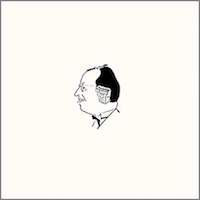
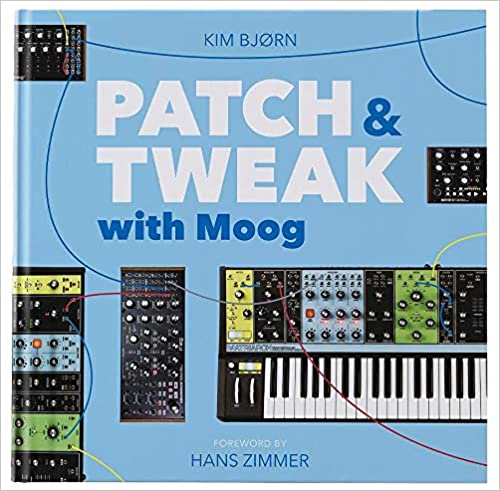







© Matrixsynth - All posts are presented here for informative, historical and educative purposes as applicable within fair use.
MATRIXSYNTH is supported by affiliate links that use cookies to track clickthroughs and sales. See the privacy policy for details.
MATRIXSYNTH - EVERYTHING SYNTH













© Matrixsynth - All posts are presented here for informative, historical and educative purposes as applicable within fair use.
MATRIXSYNTH is supported by affiliate links that use cookies to track clickthroughs and sales. See the privacy policy for details.
MATRIXSYNTH - EVERYTHING SYNTH








